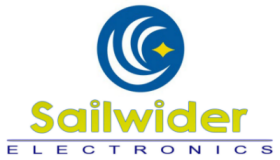|
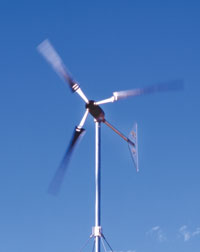
In
most small-scale designs, the
rotor is connected directly to
the shaft of a permanent magnet
alternator, which creates wild,
three-phase AC. Wild,
three-phase electricity means
that the voltage and frequency
vary continuously with the wind
speed. They are not fixed
like the 60 Hz, 120 VAC
electricity coming out of common
household outlets. The wild
output is rectified to DC to
either charge batteries or feed
a grid-synchronous inverter. In
most designs (up to 15 KW in
peak capacity), the rotor is
usually connected directly to
the alternator, which eliminates
the additional maintenance of
gears. In systems 20 KW and
larger, as well as some smaller
wind systems (like the
Endurance, Tulipo, or Aircon), a
gearbox is used to increase
alternator speed from a slower
turning rotor.
The blades must turn to face the
wind, so a yaw bearing is
needed, allowing the wind
turbine to track the winds as
they shift direction. The tail
directs the rotor into the wind.
Some sort of governing system
limits the rotor rpm as well as
generator output to protect the
turbine from high winds. A
shutdown mechanism is also
useful to stop the machine when
necessary, such as during an
extreme storm, when you do not
need the energy, or when you
want to service the system.
In most small-scale designs,
the rotor is connected directly
to the shaft of a permanent
magnet alternator, which creates
wild, three-phase AC. Wild,
three-phase electricity means
that the voltage and frequency
vary continuously with the wind
speed. They are not fixed
like the 60 Hz, 120 VAC
electricity coming out of common
household outlets. The wild
output is rectified to DC to
either charge batteries or feed
a grid-synchronous inverter. In
most designs (up to 15 KW in
peak capacity), the rotor is
usually connected directly to
the alternator, which eliminates
the additional maintenance of
gears. In systems 20 KW and
larger, as well as some smaller
wind systems (like the
Endurance, Tulipo, or Aircon), a
gearbox is used to increase
alternator speed from a slower
turning rotor.
The blades must turn to face
the wind, so a yaw bearing is
needed, allowing the wind
turbine to track the winds as
they shift direction. The tail
directs the rotor into the wind.
Some sort of governing system
limits the rotor rpm as well as
generator output to protect the
turbine from high winds. A
shutdown mechanism is also
useful to stop the machine when
necessary, such as during an
extreme storm, when you do not
need the energy, or when you
want to service the system.
How Wind Turbines are
Rated
Wind turbine rating is a
tricky affair. While
solar-electric module or
microhydro-electric turbine
production can be predicted
fairly realistically based on
rated output, this number is
very misleading with wind
turbines. Why? Because rated
output is pegged to a particular
wind speed, and different
manufacturers use different wind
speeds to determine rated
output. Also, the power
available in the wind varies
with the cube of its speed, so
small increases in wind speed
result in large increases in
power available to the rotor. A
10 percent increase in wind
speed yields a 33 percent
increase in power available in
the wind. Conversely, this means
that a turbine rated at 1,000
watts at 28 mph might produce
only 125 watts or less at half
that wind speed, 14 mph.
So what´s a wind turbine
buyer to do? Ignore the peak
output and the power curve. Look
for the monthly or annual energy
numbers for the turbine,
estimated for the average wind
speed you expect or measure at
your site. These will be given
in KWH per month (or year) in
the manufacturer´s
specifications for each turbine.
Energy is what you´re after, not
peak power! If, for example, you
are looking for a turbine that
can produce 300 KWH per month,
and you know that you have a 10
mph average wind speed at the
proposed turbine height, you can
shop for a turbine that is
predicted to generate that much
energy in that average wind
speed.
If you can´t get energy
production estimates from the
manufacturer or a turbine owner,
look for a different
manufacturer. This is basic
information that any
manufacturer should supply.
However, knowing a turbine´s
swept area may also help you
calculate the annual energy
output for the wind turbine. All
other things being equal, ″there´s
no replacement for
displacement.″ Hugh Piggott
gives a rough formula for
calculating output based on
average wind speed and swept
area in
his HP102 article. Jim Green
at the National Renewable Energy
Lab (NREL) developed a similar
formula: annual energy output (AEO)
in KWH = 0.01328 x rotor
diameter (ft.) squared x average
wind speed (mph) cubed.
A turbine´s revolutions per
minute (rpm) at its rated wind
speed can give you some idea of
the relative aerodynamic sound
of the machine, and also speaks
to longevity. Slower-turning
wind turbines tend to be quieter
and last longer. High rpm
machines wear out components,
such as bearings, much faster.
In addition, the faster blades
move through the air, the
greater the possibility that
they will waste some of that
energy as sound from the blades.
How To Choose A Wind Turbine
Trying to keep an inexpensive
wind generator running can be an
uphill battle that you'll soon
tire of. But expect to pay more
for a better machine—it´s a
tough job to design and
manufacture a long-lasting,
small-scale wind generator.
The bottom line: Buy a turbine
that has a very good track
record and a good warranty—five
years is preferable but not
always available in the small
wind industry. A warranty is one
indication of the manufacturer´s
confidence in their product, and
their intention to stand behind
it.
Real-world reports from users
carry even more weight than a
warranty, so search for people
who own the model of turbine
you´re considering buying, and
get the straight scoop from them
about performance, durability,
reliability, and maintenance
issues.
Note that a number of the wind
turbines listed here are
relatively new introductions
with not very much customer
run-time in North America. These
turbines include the ARE, Eoltec,
Kestrel, and Skystream. We
recommend that you contact
either your local wind turbine
installer, or the manufacturers
or importers and find out how
many of these machines are
actually operating in North
America. Then contact the
owners, and inquire about their
experience and satisfaction with
both the machine and the
manufacturer or importer.
Some manufacturers make only
battery-charging machines, and
may offer a variety of turbine
voltages. Others produce
machines intended to connect to
grid-synchronous inverters
without batteries. One machine
even includes an inverter
integrated with the turbine
itself. Make sure you´re buying
a machine that is appropriate
for your intended use.
When you look at prices, keep in
mind that just buying a wind
turbine will not get you any
wind-generated electricity.
You´ll also need most or all of
the components mentioned
elsewhere. Also budget for
equipment rental, like a backhoe
and crane, concrete and rebar,
electrical components, shipping,
and sales tax. Unless you do all
of the work yourself, also
factor in installation labor
expenses. These costs can add up
significantly, so make sure that
you research and understand all
of the associated expenses
before committing to a purchase.
Many people are quite surprised
to learn that the wind turbine
cost can range from only 10
percent to as much as 40 percent
of the entire wind system´s
expenses.
Small-scale wind energy is not
for the half-hearted,
uninvolved, or uncommitted, and
probably not for folks who never
change the oil in their vehicles
(or are willing to spend the
bucks to hire someone to do the
tower work). The North American
landscape is littered with
failed installations: Designs
not fully thought-out or tested,
machines bought because they
were cheap, and installations
that required more time and
money for repairs than they ever
yielded in electricity
generated. Many of the failures
were the result of wishful
thinking and too little
research. That said, there are
tens of thousands of happy
wind-electric system owners.
These owners did their
homework—purchasing, designing,
and installing rugged and
well-thought-out systems on
adequately sized towers. In
addition, they are either
committed to maintaining the
systems, or to hiring someone to
do this regular work.
While many first-time wind
turbine buyers may be looking
for a bargain, second-time wind
turbine buyers are seeking the
most rugged machine they can
afford. You can avoid a painful
"learning experience″ by
focusing on durability,
production, warranty, and track
record, and not on price alone,
or on peak output. You don´t
want to depend on the low bidder
for something as important to
you as your long-term energy
investment.
There is a lot of
preparatory work to do
before you get to see your
wind turbine’s blades spin.
It includes understanding
how much energy you need (or
want), how to use energy
efficiently, how much wind
energy you have available at
your site, and how to match
your needs with your
resource. After you’ve
covered this ground, you can
start to consider which wind
turbine and what balance of
system components to buy,
and how to install them.
Energy Analysis
First
If you want to
install a wind-electric
system, the first step is to
determine how much
electricity you use.
Electrical energy is
measured in kilowatt-hours
(KWH), and one way or
another, you need to
discover how many of them
you use per month. You could
learn to read your utility
meter and check it multiple
times over the year. But
it’s easier to simply
contact your utility, which
will usually supply a
summary of the past year’s
electrical usage.
If you’re planning a new
home, you’ll need to
estimate your electrical
use. Reviewing utility bills
from your current home may
give you a good estimate if
you’re going to use a
similar range of appliances.
But in the end, this will
only be a guess, since your
actual usage may vary
considerably.
The goal of the analysis is
to come up with the number
of KWH per year that you
want your wind system to
generate. Without this
number, you’re guessing, and
may end up being unhappy
with your investment in wind
power. If you say you want
to make “a lot” of
electricity, wind energy
experts will tell you that
the system will cost “a lot”
of money. If you say you
want to make 150 KWH per
month, your renewable energy
installer will be able to
suggest a few turbine
options and give you a cost
in dollars, or at least an
informed estimate.
Efficiency Next
Once you know how many KWH
you use or expect to use,
you could proceed to “Go”
and start shopping for
wind-electric system
components. But your time
and money will be better
spent by first focusing on
energy efficiency. Typical
Americans can reduce their
home’s energy use by 20% to
50% (or more) by using more
efficient lighting and
appliances, defeating
phantom loads, and simply by
being determined to use
less.
The Specifications table on
pages 32 and 33 shows basic
specs for home-scale wind
turbines available and
supported in North America.
Understanding the
specifications will help you
make intelligent choices
when it’s time to buy your
turbine.
Manufacturer/importer
contact information is
included in the Access
section at the end of this
article. In some cases, the
wind turbines are either
remanufactured or imported.
For imports, the North
American contact is listed.
Swept area of the rotor is
the area in square feet of
the circle “swept” by the
blades. This is the “wind
collector” area and, besides
your average wind speed, is
the single largest factor
influencing turbine output.
A larger rotor will give you
more energy, all other
things being equal (and they
usually are).
Rotor diameter is directly
related to swept area. It
would be handy to use the
square footage of the rotor
as an identifier for
turbines. More often we use
diameter, though it’s hard
for most people to quickly
determine swept area from
rotor diameter figures.
Although the difference
between a turbine with an
8-foot-diameter and one with
a 10-foot-diameter might not
seem large, it represents a
58% increase in collector
size, with a proportional
increase in energy output.
Tower-top weight is
necessary to know when
choosing your tower, along
with swept area. A heavier
turbine also may be an
indication of a more rugged
machine. Though weight
itself doesn’t necessarily
translate into turbine
longevity, a rugged turbine
that holds up over the long
haul often results from a
heavier machine.
Annual energy output (AEO)
at 8 through 13 mph gives
you some general numbers to
match to your site’s average
wind speed and energy needs.
Note that all AEOs provided
in the table are either from
the manufacturer or derived
from manufacturer’s data.
Your turbine’s performance
on your site may vary,
sometimes significantly. Be
conservative, by choosing
the next larger turbine when
you’re not sure of your
exact energy use or if the
exact size turbine you need
is not available. Also, AEOs
apply to locations from sea
level to 1,000 feet in
elevation and must be
adjusted for lower air
density at higher altitudes.
Your installer or turbine
manufacturer can help you
crunch these numbers.
Rpm is the blade revolution
speed at the turbine’s rated
output and relates to two
factors in wind generators:
durability and sound
production. A slower rotor
speed will generally mean a
longer-lasting turbine—less
wear and tear on the
rotating parts. It also
usually means a quieter
turbine. Note that lower rpm
does not mean lower
production, nor does higher
rpm mean higher production.
In both cases, the
alternator is matched to the
rotor speed to get as much
energy out of the wind as
possible.
Governing system describes
the method the turbine uses
to shed excess energy in
high winds to protect the
turbine from overspeed. Some
turbines tilt, or “furl,”
the rotor directly up or to
the side, while others furl
at an angle. Still others
use blade pitch control,
turning the blades out of
their optimum aerodynamic
angle, so that they don’t
capture as much energy.
Blade pitching more reliably
protects the wind generator.
Machines that have this
feature cost more (due to
more moving parts and
complexity) than machines
that furl.
Governing wind speed is the
point at which the turbine
starts governing. A low
governing speed shows that
the turbine designer was
conservative—more interested
in long-term operation than
squeezing out a bit more
energy from infrequent high
winds.
Shutdown mechanism is
different from governing,
and refers to a method to
stop the turbine for
service, in an emergency, or
when you just don’t need the
energy. Many small turbines
have no mechanical means to
shut them down. Instead,
they rely on dynamic braking
(electrical shorting of the
windings), which does not
always work, especially when
needed in higher winds.
Mechanical brakes are
usually more reliable than
dynamic braking. Generally,
more expensive wind turbines
have more reliability and
redundancy built into their
shutdown mechanisms.
Batteryless grid-tie tells
you whether the turbine is
available in this
configuration, normally the
most cost-effective choice.
All battery-charging
turbines can be grid-tied
via a battery-based inverter
designed to synchronize its
output with the utility
grid, if you’re determined
to have protection from
utility outages. But this
approach will incur
inefficiencies, losses, and
additional cost.
Battery voltages are listed
for battery-charging
turbines, so you can choose
the right turbine voltage
for your battery bank. Most
modern whole-house
battery-based RE systems
today use a 48 V battery
bank (with an inverter to
supply the house with 120 or
240 VAC).
Controls included are what
you get when you buy the
turbine—whether it includes
a controller, a dump load,
and metering. These
components can be expensive,
so don’t forget to add them
into your calculations if
they are not included.
Cost is for the turbine and
any included controls, in
U.S. dollars. This is only
one component in the system,
and usually not the most
expensive one. A tower,
batteries, and inverter each
can easily exceed the
turbine cost. Note that the
EW 15, V-15, V-17, and PGE
turbines also include tower,
wiring, all installation
materials, and labor costs.
Warranty is an indication of
the manufacturer’s
confidence in the machine,
or is set to meet the
requirements for incentive
programs in states such as
California. Find out what is
covered—usually it’s
equipment only, and not the
costs of replacement labor,
which can be significant.
Several of the manufacturers
that offer shorter than
five-year warranties will
extend the warranties for an
additional cost.
What we’re not listing is
rated or peak power. That
data is close to meaningless
and a distracting marketing
ploy. One cannot accurately
predict annual energy output
(which is what you want to
know) from peak power, since
two machines with similar
peak power can give very
different energy outputs.
Selecting Your
Turbine
Now that you know your needs
and you’ve determined your
resource, it’s time to go
shopping. Any wind turbine
manufacturer worth buying
from can supply you with
annual energy output (AEO)
numbers for various average
wind speeds. You simply need
to choose a turbine that
will produce the amount of
energy you need with your
wind resource. If you
determine that you want to
generate 2,100 KWH per year
in your 11 mph average wind
regime, check out the
manufacturers’ output
predictions to see what’s
available.
For off-grid applications,
you’ll need to consider
seasonal energy usage. If
your windiest season matches
up with your heaviest use of
energy, you’ll make the most
of your system. But in other
cases, you may need to
oversize your wind turbine
to cover the seasonal load
variation. And with off-grid
systems, you will almost
certainly need a second
source of energy, like solar
electricity.
Balance of Systems
A wind turbine is just one
part of a system. You’ll
need other components to
actually make electricity.
Though the wind generator is
a critical component to buy
well, you should give
similar attention to the
other parts of the system.
Your tower design will be
determined by the weight and
swept area of your wind
generator, the specifics of
your site, and your
preferences and budget. (See
the tower article referenced
in Access for more
information.) The best
suppliers of wind generators
also supply towers, knowing
what is appropriate for
their machines.
System electronics include
charge controllers,
inverters, and metering.
Sometimes these are included
with the turbine, and other
times you have some
choices—depending on whether
your home is off-grid or on,
battery-based or
batteryless. Make sure you
understand the options, as
these components must be
matched to the turbine and
to other parts of your
system.
Batteries are a big subject,
and if you intend to use
them in your system, you
should educate yourself.
Off-grid users must
carefully consider how much
storage they want, and
whether they will use backup
or other energy sources like
PV.
Do It Right!
If you’re a novice at
electrical and mechanical
installations, don’t even
consider taking on a wind
turbine installation
yourself. Because of gravity
and the tower heights
involved, this is serious
business—fraught with
potential danger to life and
limb, as well as the
opportunity to make poor
design and installation
decisions that could affect
performance and safety over
the life of the system. If
you have any doubt about
your abilities, hire a
professional. Think of this
system like an automobile.
Most of us don’t even do our
own auto maintenance; much
less would we would even
consider designing and
building a vehicle. Wind
electricity is not an easy
DIY project, and may never
be, since it requires tall
towers to get the turbine up
into its “fuel.”
Wind-electric systems are
not easy, simple, cheap, or
perfectly reliable. But if
you do your homework, buy
quality equipment, and get
the help you need, you can
end up with a long-lasting
and satisfying system.
Thousands of families have
done just that, and they
look up regularly to see
their turbine spinning,
making electricity from the
wind!
Electricity Energy Monitor
(Sailwider-SmartPower's monitor
can be used to monitor home
wind/solar plant)
Wireless Electricity
Energy Control System with
monitoring function for Home
Solar Power Generator Plant
The basic figures contained
within a monthly or quarterly
electricity bill do not give you
much information as to where
your electricity is going - they
just tell you how much you have
used in total during that period
and how much totally you need to
pay. Therefore it is well worth
considering purchasing an
electricity usage monitor and
using it to see exactly where
all your hard-earned money is
going.
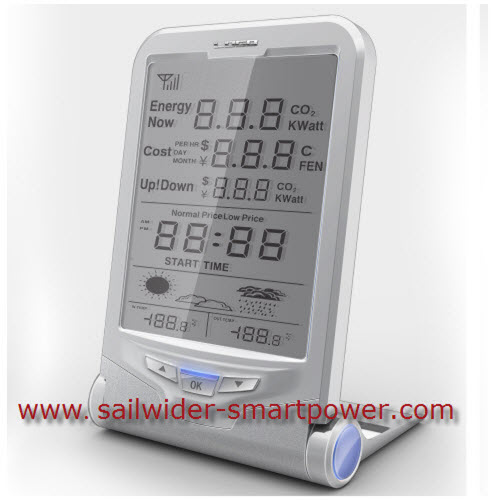
One great way to find out how
much electricity each of your
household appliances and
electronic devices uses is with
a wireless electricity
power/energy monitor, which
shows you in real time exactly
how much money your total home
or office electricity usage is
costing you. These monitors can
help you reduce your electricity
consumption by as much as 20%
simply by showing you what you
are using.
Sailwider-SmartPower is a developer and
manufacturer of electricity power
monitor and controlling system.
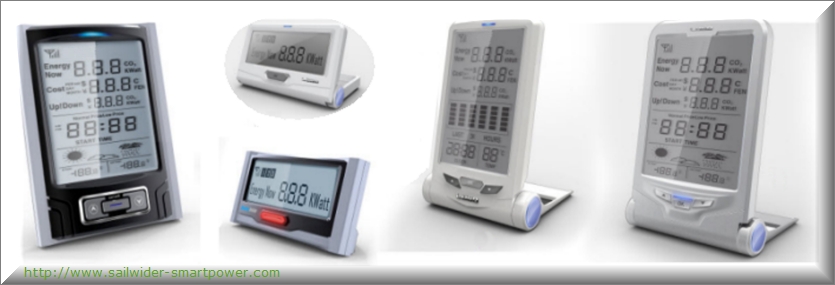
Most electricity energy monitors
in the market are uni-directional
(1-way) only, that means you can only
get energy consumption
information from the monitor.
The
bi-directional (2-way)
electricity power monitoring and
control system
from Sailwider-SmartPower makes
the user not only able to
monitor the electricity usage,
but also can easily remote control
the connected electrical
appliances wirelessly, providing great
convenience to electricity
efficiency management.
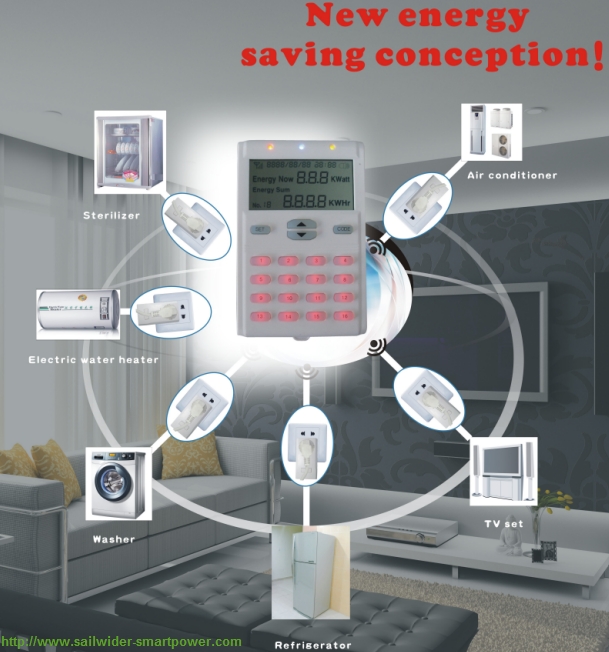
Our
smart electricity energy monitors with home
solar plant monitoring function belongs to our
uni-directional electricity monitoring system and is developed specially for
households installed with home solar plant, providing a perfect
solution for the home owners to monitor both the home
electricity consumed in total and the energy produced by solar.
Meanwhile, the system displays the balance between the
consumption and production to the family members. This system is
only for monitoring purpose, if you also want the system with
appliances control function, please refer to our
wireless energy control system with home solar monitoring
function. |
